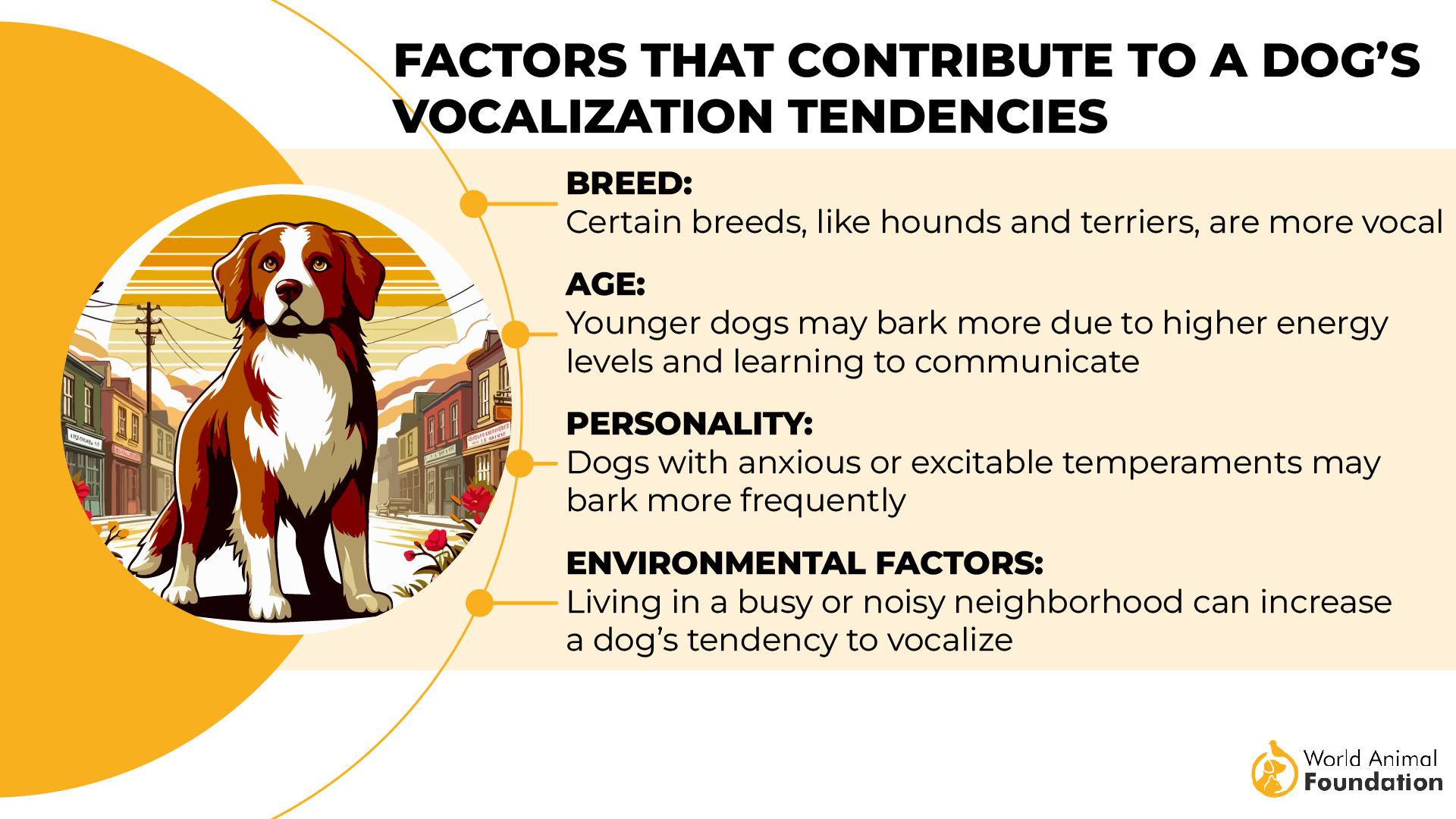Barking is a natural form of communication for dogs, but some breeds are more vocal than others. Understanding which breeds are predisposed to frequent barking can be essential for prospective pet owners looking to make informed decisions. While barking serves various purposes—from alerting to expressing excitement—some dogs have a reputation for being particularly expressive. In this exploration of the seven dog breeds that bark the most, we delve into the characteristics that drive their vocal behavior, offering insights for those who value a quieter household or, conversely, those who appreciate an enthusiastic canine communicator.
Let’s talk bark, shall we? Some dogs are content to remain quiet, lounging lazily while observing the world. But then, there are the stars of the canine orchestra—the noisiest dog breeds—that simply can’t help stealing the spotlight. Generally speaking, these pups don’t bark; they communicate, loudly and with great enthusiasm!
Why all the fuss? Well, these dogs are curious, alert, and eager to share their opinions on, well, everything. From squirrels to delivery trucks, they’ve got something to say. While their barking tendencies might make your neighbors question your life choices, they’re also why we love them.
So, if you’re someone who enjoys a running commentary with your wagging tail, you’re in for a treat. Let’s dive into the barking hall of fame and meet the furry chatterboxes who never run out of things to “say”!
Dog Breeds that Bark the Most
1. Beagle
|
Life Span |
12–15 years |
|
Origin |
England |
|
History |
Originally bred for tracking and hunting small game |
|
Barking |
Loud, persistent barking with occasional howling |
Beagles are medium-sized dogs, weighing 20–25 pounds and standing 13–15 inches tall. These cheerful pups are the ultimate canine companions, thanks to their friendly demeanor. However, their barking tendencies are undeniable. Beagles use their voices to communicate with their human family, alerting them to new scents, strangers, or changes in their surroundings.
Why all the noise? Britannica claims that Beagles were originally bred to hunt and track, making them highly alert and prone to persistent barking. While their big bark might be endearing, consistent training and plenty of exercise can help manage their tendency to bark.
With a short, easy-to-maintain coat and a love for other animals and humans alike, Beagles are the perfect mix of loyalty and liveliness for dog lovers.
2. Pomeranian
|
Life Span |
12–16 years |
|
Origin |
Germany/Poland |
|
History |
Originally bred from larger sled-pulling Spitz breeds |
|
Barking |
High-pitched, frequent barking due to alertness |
Pomeranians are tiny but mighty little dogs, tipping the scale at just 3–7 pounds. Don’t let their size fool you—they have a big bark and aren’t afraid to use it! These fluffy charmers have strong protective instincts, barking to alert their human family of any strangers or changes in their surroundings.
Their barking tendencies stem from their history as watchdogs, and they are naturally prone to persistent barking. VCA suggests that early socialization and mental stimulation can help reduce their tendency to bark excessively.
With a fluffy coat that demands regular grooming, Pomeranians are perfect for those who enjoy an energetic, vocal, and loyal canine companion. They’ll keep you entertained—and your neighbors guessing!
3. Dachshund
|
Life Span |
12–16 years |
|
Origin |
Germany |
|
History |
Bred as hunting dogs for badger burrows |
|
Barking |
Often bark loudly to alert owners of unfamiliar situations |
The Dachshund, affectionately called the “sausage dog,” is a small-sized breed weighing 16–32 pounds, depending on its variety. With their long backs and stubby legs, these dogs are unmistakably unique. Dachshunds are highly intelligent, making them great for learning tricks, though their independent streak can pose a training challenge.
They are among the most vocal dog breeds, especially when they encounter intruders or hear other dogs barking. This tendency stems from their past as hunting dogs, bred to alert their handlers underground. To curb their barking, engage them in regular mental stimulation and training.
Dachshunds have short coats that are easy to maintain, though long-haired varieties require more grooming. Their feisty attitude, wagging tail, and loyalty make them a favorite breed for dog lovers worldwide!
4. Chihuahua
|
Life Span |
14–16 years |
|
Origin |
Mexico |
|
History |
An ancient breed, possibly dating back to the Aztecs |
|
Barking |
High-pitched, often barking to assert dominance or due to fear |
Chihuahuas may be small dogs, but they carry themselves with the confidence of larger animals. Weighing 3–6 pounds, they are perfect for apartment dwellers and can fit comfortably in almost any living space.
Despite their size, Chihuahuas are big barkers with a high-pitched sound that can startle. PetPlan notes that they bark due to their strong sense of alertness in unfamiliar situations or as a way to assert their dominance. While their bark can be intimidating, consistent training can help manage it.
These tiny dogs are low-maintenance when it comes to grooming but thrive on attention and cuddles. Energetic, loyal, and full of personality, they’re a hit among dog lovers who enjoy a spirited companion.
5. Miniature Schnauzer
|
Life Span |
12–15 years |
|
Origin |
Germany |
|
History |
Developed as rat-catching farm dogs |
|
Barking |
A sharp, loud bark to alert or warn |
The Miniature Schnauzer is a small-sized breed, standing about 12–14 inches tall and weighing 11–20 pounds. These dogs may look dapper with their bushy eyebrows and beard, but they pack an intimidating bark for their size.
Schnauzers were bred to alert farmers of intruders and prey, making them noisy dogs. They bark to express boredom, and excitement, or to warn of unfamiliar situations. Training them early to recognize real threats can save your neighbors a lot of noise!
They’re highly intelligent and energetic, thriving with regular exercise. Their wiry coat needs periodic grooming, but otherwise, they’re easy to maintain. With their strong sense of loyalty, Schnauzers are a fantastic choice for active families or dog lovers.
6. West Highland White Terrier
|
Life Span |
12–16 years |
|
Origin |
Scotland |
|
History |
Bred as hunting dogs for small prey like foxes |
|
Barking |
Frequent, high-pitched barking to alert |
West Highland White Terriers, or “Westies,” are small dogs weighing 15–20 pounds and standing about 10–11 inches tall. These pint-sized pups are fearless and have the personality of a fox terrier, with plenty of energy to boot.
Westies are among the most vocal dog breeds, often barking at unfamiliar sights, sounds, or smells. This stems from their heritage as hunting dogs. Proper training and activities like agility can reduce barking caused by boredom.
PetMD advises that their crisp white coat requires regular grooming to maintain its fluffiness. Despite their size, they tend to believe they’re much larger and aren’t afraid to stand up to larger animals. Westies are perfect for dog lovers who adore spunky and confident companions.
7. Yorkshire Terrier
|
Life Span |
13–16 years |
|
Origin |
England |
|
History |
Bred to catch rats in textile mills |
|
Barking |
High-pitched, frequent barking, especially in excitement |
The Yorkshire Terrier, or “Yorkie,” may be one of the many small breeds, but they’re packed with sass and energy. Weighing 4–7 pounds, they’re ideal for apartment dwellers but have a bark that could rival the loudest dog breeds like a Siberian Husky.
Their barking often signals excitement, unease, or a response to other noisy dogs. While they can be trained to curb excessive barking, they’ll always remain alert watchdogs.
According to Purina, Yorkies boasts a silky coat reminiscent of a poodle, needing regular brushing and trims. Despite their petite size, they carry themselves with the confidence of a Doberman Pinscher. Their loving nature and adorable wagging tail make them a favorite breed for urban dog lovers.
Conclusion: The Symphony of Vocal Dog Breeds
So, what have we learned, dear dog lovers? When it comes to barking, these breeds are the undeniable maestros of noise. Whether it’s the pint-sized sass of the Chihuahua or the boisterous bravado of the Miniature Schnauzer, some dogs are born to make themselves heard—and make sure you know it!
But let’s not forget the other contenders in the world of barkdom. German Shepherds, with their commanding voices, are herding dogs that mean business. The Cairn Terrier and Alaskan Malamute also deserve applause for their ability to make neighbors question your life choices. And while most dogs love a good bark, some, like the Basset Hound, prefer an occasional howl, while the Maltese embrace being a portable alarm system.
Of course, there’s the Basenji, the mysterious barkless dog, proving silence can be golden—unless you prefer a large-sized soundtrack for your life.
In conclusion, understanding the barking tendencies of different dog breeds is crucial for potential dog owners who prioritize a quieter environment. The seven breeds known for barking the most often do so due to their inherent traits, bred for alertness, protection, or herding. While these breeds, such as Beagles, Chihuahuas, and Terriers, can bring immense joy and loyalty, prospective owners should be prepared for their vocal nature. Training and socialization can mitigate excessive barking, making these energetic and alert companions manageable in a home setting. Choosing the right breed aligns an owner’s lifestyle with their pet’s natural behavior, enhancing the bond.










